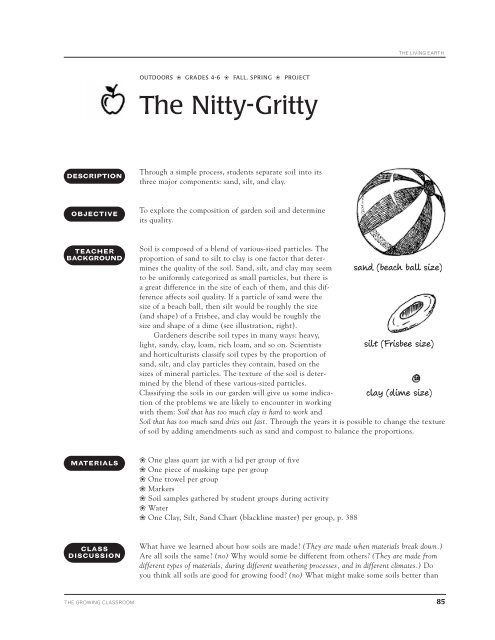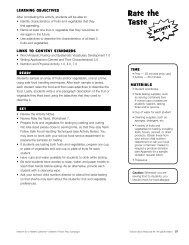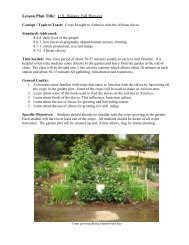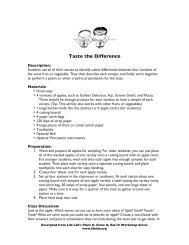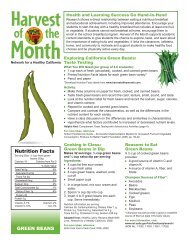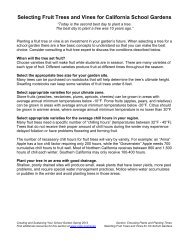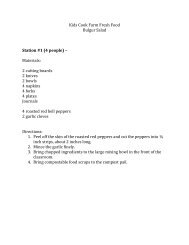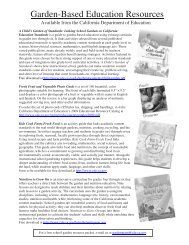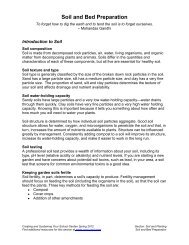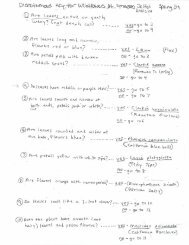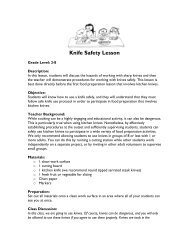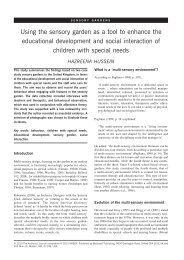Nitty Gritty_Determing Your Soil Texture.pdf
Nitty Gritty_Determing Your Soil Texture.pdf
Nitty Gritty_Determing Your Soil Texture.pdf
Create successful ePaper yourself
Turn your PDF publications into a flip-book with our unique Google optimized e-Paper software.
THE LIVING EARTH<br />
OUTDOORS ❀ GRADES 4-6 ❀ FALL, SPRING ❀ PROJECT<br />
The <strong>Nitty</strong>-<strong>Gritty</strong><br />
DESCRIPTION<br />
Through a simple process, students separate soil into its<br />
three major components: sand, silt, and clay.<br />
OBJECTIVE<br />
To explore the composition of garden soil and determine<br />
its quality.<br />
TEACHER<br />
BACKGROUND<br />
<strong>Soil</strong> is composed of a blend of various-sized particles. The<br />
proportion of sand to silt to clay is one factor that determines<br />
the quality of the soil. Sand, silt, and clay may seem sand (beach ball size)<br />
to be uniformly categorized as small particles, but there is<br />
a great difference in the size of each of them, and this difference<br />
affects soil quality. If a particle of sand were the<br />
size of a beach ball, then silt would be roughly the size<br />
(and shape) of a Frisbee, and clay would be roughly the<br />
size and shape of a dime (see illustration, right).<br />
Gardeners describe soil types in many ways: heavy,<br />
light, sandy, clay, loam, rich loam, and so on. Scientists silt (Frisbee size)<br />
and horticulturists classify soil types by the proportion of<br />
sand, silt, and clay particles they contain, based on the<br />
sizes of mineral particles. The texture of the soil is determined<br />
by the blend of these various-sized particles.<br />
Classifying the soils in our garden will give us some indication<br />
of the problems we are likely to encounter in working<br />
clay (dime size)<br />
with them: <strong>Soil</strong> that has too much clay is hard to work and<br />
<strong>Soil</strong> that has too much sand dries out fast. Through the years it is possible to change the texture<br />
of soil by adding amendments such as sand and compost to balance the proportions.<br />
MATERIALS<br />
❀ One glass quart jar with a lid per group of five<br />
❀ One piece of masking tape per group<br />
❀ One trowel per group<br />
❀ Markers<br />
❀ <strong>Soil</strong> samples gathered by student groups during activity<br />
❀ Water<br />
❀ One Clay, Silt, Sand Chart (blackline master) per group, p. 388<br />
CLASS<br />
DISCUSSION<br />
What have we learned about how soils are made? (They are made when materials break down.)<br />
Are all soils the same? (no) Why would some be different from others? (They are made from<br />
different types of materials, during different weathering processes, and in different climates.) Do<br />
you think all soils are good for growing food? (no) What might make some soils better than<br />
THE GROWING CLASSROOM 85
THE LIVING EARTH<br />
THE NITTY-GRITTY<br />
others? (good drainage, ability to hold nutrients, easy to dig, lots of living things) In this activity,<br />
we are going to do a simple demonstration to determine the parts of soil. We will find out if<br />
it will be hard or easy to dig and if it holds water.<br />
ACTION<br />
1. Divide the class into groups of five. Give each group their materials.<br />
2. Fill each quart jar about 2 /3 full of water.<br />
3. Demonstrate how to take a soil sample. First dig a few inches (2 to 7 cm) below the surface.<br />
Then carefully scoop up soil for the sample.<br />
4. Help each group select a different location in the garden or schoolyard to take soil samples.<br />
5. Instruct each group to add soil to their jar until it is almost full, then put the lid on the jar.<br />
6. Have groups label the jar lids with the group name and soil location.<br />
7. Have students shake each jar vigorously. Let the soil settle. Have each group observe their<br />
jar. What do they see happening? (In a short time the heaviest sand particles sink to the bottom<br />
and the sand layer becomes visible, but the silt and clay particles will take hours to settle.)<br />
8. Place the jars in a location where they may be easily observed. Be sure no one lifts the jars<br />
to observe them.<br />
9. In 24 hours the soil will be completely layered. Have each group describe the layers.<br />
Which layer is on the bottom? (one with the heaviest, biggest particles) Is that the same for<br />
each group? Which layer is the thickest? (Answers may vary.) How do you think the thickest<br />
layer will affect your soil for gardening?<br />
10. Each group can use the Clay, Silt, Sand Chart, p. 388, to determine their soil name.<br />
Then have them mark off the layers on a piece of paper held up to the jar, as shown on<br />
the chart, and compare each one to the chart. If the particles divide into about 40%<br />
sand, 40% silt, and 20% clay, the soil is called loam — a very good kind of soil to have.<br />
If the soil falls into other classifications, you could add sand or organic matter to change<br />
its classification.<br />
WRAP UP<br />
Were all of the soils the same? How did they differ? What are the three different particles in<br />
soil? Which is the biggest? Which is the smallest? What do you predict will make your soil<br />
better for gardening? Why? Which soil sample will be easiest to dig? Which will not let<br />
water drain?<br />
DIGGING<br />
DEEPER<br />
Keep a soil history from year to year for comparison.<br />
86 THE GROWING CLASSROOM
APPENDIX: BLACKLINE MASTERS<br />
Clay, Silt, Sand Chart<br />
(From: The <strong>Nitty</strong>-<strong>Gritty</strong>, p. 85)<br />
SOIL CHART<br />
CLAY LOAM<br />
CLAY LOAM<br />
CLAY<br />
SILT<br />
SAND<br />
SILT<br />
LOAM<br />
SILT<br />
15%<br />
60%<br />
25%<br />
5%<br />
85%<br />
10%<br />
LOAM<br />
SANDY LOAM<br />
20%<br />
40%<br />
40% 35%<br />
35%<br />
10%<br />
20%<br />
70%<br />
5%<br />
10%<br />
85%<br />
LOAMY SAND<br />
2%<br />
CLAY LOAM<br />
CLAY<br />
30%<br />
60%<br />
20%<br />
20%<br />
CLAY<br />
3%<br />
95%<br />
SILT<br />
SAND<br />
SAND<br />
388 ©Copyright Life Lab Science Program, Inc. (Published by the National Gardening Association) THE GROWING CLASSROOM


